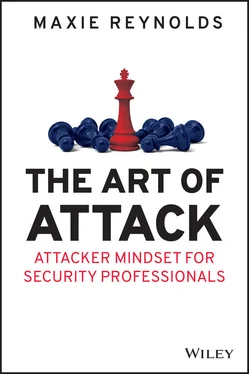You should be focused, intense, aiming to win, and primed to take advantage of any opportunity for success that real-life attacks provide, also known as mental agility. Note that, even if you plan an attack within an inch of its life, you will still not be able to accurately account for the actions and reactions of your targets. Without mental agility, an attacker may be good, but they will never be great.
Planning in and of itself will not lead you to feel pressure, but insisting you stick to the plan will. It is also likely lead you to failure. You must be able to interact and react to the environment. No one wakes up and says to themselves, “Well, today is the day I will not react to my environment.”
Sometimes we get so set on winning that we get tunnel vision on the one route we want to take, not the one that's opening up in front of us. You must be able to adapt. When nothing is going as planned, you have to be able to pivot. When everything is going as planned, you should still recognize the opportunity to pivot, especially if it leads to a shortcut.
I've had to pivot more times than I've had hot dinners, and thankfully, not all have led to success. One of my first jobs saw me turn up at a small office as an IT consultant, which wasn't all that far from the truth. I was promptly introduced to the facilities manager, who was exceptionally nice to me. She gave me a cup of tea, and I told her about my love of British biscuits because I saw some in the kitchen, and I am not above hinting. Mere minutes later I had enough to eat and to take home. News of an IT consultant's arrival soon traveled, and not too long after I had staff coming up to me inquiring about some issues they were having on their computers—enter the pivot!
I, of course, agreed to take a look so that I could open a command prompt—allows you to run programs, manipulate Windows settings, and access files by typing in commands, the perfect low-key privilege escalation I'd been looking for. After a few minutes poking around pretending I knew what I was doing, I opened Terminal and took a discreet photo and thought I'd be on my merry way—except someone asked me a very simple question that any IT professional would know, and I crumbled like a two-day-old British biscuit. They saw me crumble, and minutes later the whole operation was on its knees because the manager of the office insisted on calling my cover company, which didn't exist. All because I couldn't recall what RAM stands for. (I can now at all times.) I still managed to pivot. When there was no answer on the other end of the line, mainly because it was ringing the burner phone in my pocket, I soon began to act indignant. I left papers to sign and told them where they could send them and got on my way.
This is the other advantage of OAMs: when you're under pressure, an offensive edge makes continuing the operation less challenging. Being able to pivot suddenly to continue trying to achieve the objective is a specialist skill. Mine let me down only when I got so flustered by an unexpected question that I couldn't recall the words random access memory. But it picked back up when I felt the heat rise and the possibility of arrest become a real threat.
Using OAMs to combat the pressures of planning and pivoting is, admittedly, easy to comprehend in theory but hard to practice. Learning this mental skill on the job is among the trickiest of things to do, but it's possible. There is definite value in seeking out stories from people who succeeded in pivoting and from those who have not.
Ultimately, using OAMs under pressure provides the ability to develop effective contingency plans, which is a critical mental skill for frequent decision-making, not only while in an active attack scenario but leading to that time as well. As an aside to this, for some people it will take time to learn this particular offensive strategy—working under pressure is on a spectrum, not a case of “you can” or “you can't,” so we can all do it to varying degrees. Finding ways to build up this skill is tantamount to success as an ethical attacker, because it's a constant when you're out in the field. It may be adding a little more stress to your current role; it may be building up physical challenges. The point is that you have to build up your tolerance from stress and become increasingly immune to its effect on your critical thinking. For some people, it will seem to come naturally. Many of the individuals I've come across that have found picking up this skill easy have had seemingly tough initial conditions or have had experiences that have made using skills like this one second nature. It is definitely something you can learn if you aren't quite a whiz under pressure yet. Breathing is your greatest tool, as nuts as that sounds. But checking in on your breathing in moments of stress isn't some hippie-dippie technique. It works. It helps you process what you are feeling, which is most likely what's prohibiting you from thinking clearly. Lean into it and let it pass. You will become better and better, faster and faster at it.
Another component of OAMs is the ability to visualize, create, and construct scenarios based on information, which should serve to keep things straight in your mind. There's a game of mental chess to be played before each attack, as I've mentioned frequently. However, you cannot assume that you will conjure up the exact scenarios you will walk into, because there's no conceivable way to picture every act, action, and reaction that may occur. This ability to visualize is not shorthand for “manifestation.” It's simply a good offensive warm-up strategy that can get the offensive juices flowing, so to speak. It's a skill you can build up now that will help your future self—and it makes thinking critically in the moment easier.
The brain is the strongest force in the body. It can overcome many adverse things, especially if you practice mental preparation. This practice can allow you to far exceed your physical and even mental limitations, but you have to train your brain for it. This sort of training relies on two things that you will need to do and use: first, be prepared to use the fourth law of AMs; make every move count in the direction of the objective.
Second, you must also be able to employ situational awareness , which is essentially knowing what is going on around you. That's a broad definition, but there are items that you should look at. Above all else, start with entry control and access. There are two ways you must pay attention to these things: you must know how you are entering and how you can exit. This is true of network pen tests when exfiltrating information and covering your tracks, to vishing tests where starting and ending the call naturally enough so as to not invoke a negative feeling from the target is often essential. You never want to raise suspicions. You must also try to gauge how porous the establishment is overall. Both may include looking at doors, gates, fences, walls, windows, skylights, even sewage pipes. Look for how easily vendors gain access, where they park, and so forth. You should look for wall and ceiling cameras and even body cameras. You should try to be aware of motion sensors and other barriers. In a sense, attacker mindset and attacking is part of the built environment; the design of any structure always implies a way to exploit it.
Just as architecture and crime intersect, so, too, does efficient crime intersect with cities and even neighborhoods. You should also consider both of these. For example, if you were to think like an attacker breaking into a bank in Los Angeles, you might consider how far you are from one of the Freeways, the main links connecting downtown and the suburbs, which spread throughout the region in a vast network of concrete ribbons. You would study where exactly you were headed after the heist and not time the operation for rush hour. As an ethical attacker you might not need to think of these things as you have tangible confirmation that you are there to test security, typically in the form of a letter from someone high up within the organization, but because a real attacker does not, they will think about the broader logistics. You might also consider that Los Angeles, a sprawling county composed of a series of widely dispersed settlements, is heavily policed from the air—more so than any other US city, and that getting away without law enforcement being informed is of the utmost importance to your get-away being a success. But Manhattan, NY, on the other hand, is not anything like this. Its long, skyscraper-lined streets make policing from the air more cumbersome. It would also be notable to an attacker that Manhattan is surrounded by water, making alternative methods of escape plausible. Not to mention the elaborate, comprehensive subway system—another area hard to police effectively. However, the streets of New York lend themselves to police cars chasing suspects pretty well, and the plethora of alleyways that result in dead ends can make escape hard should the authorities or security be alerted of your operation.
Читать дальше












